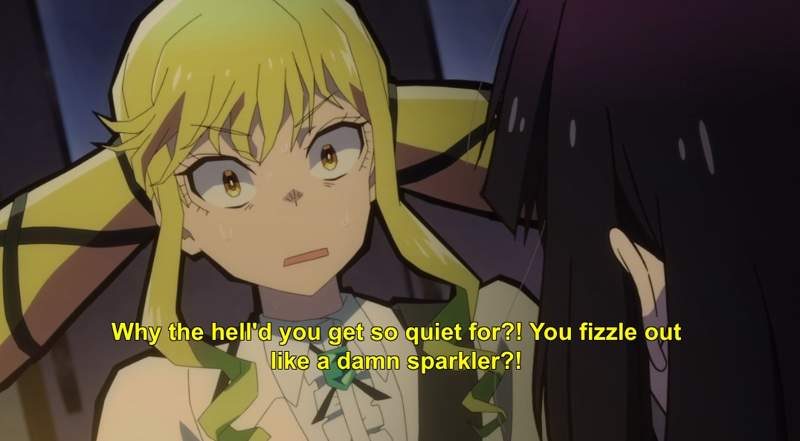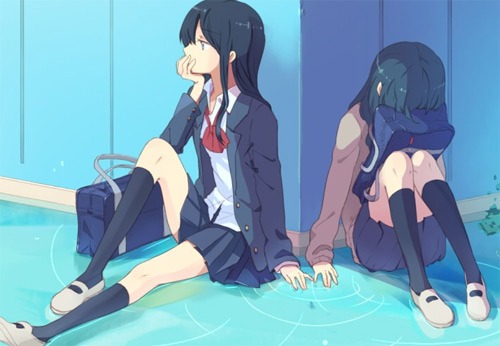Rock is a Lady’s Modesty sits in the girl-band category and within the yuri genre. Categories can span different genres. Girl-band stories can fit in the yuri genre, shojo genre, and other genres, for example. Rock is a Lady’s Modesty has overt lesbian tones to it, but with a twist. In order to discuss the story’s themes and character arcs, I will need to spoil the plot. But first, as a metal head–something that surprises many people, but then I also enjoy opera and classical music–watching these animated young ladies rock out is fun. This is helped along by the use of motion-captured 3D animation. The members of the Japanese rock band Band Maid provided the motion capture. As a long-time listener of Band Maid, I had to check out this anime once I heard about it. While you can tell during these scenes that everything is 3D animated, as opposed to the anime’s regular 2D animation, the scenes blend well. The scenes also work to convey how the characters enter a different frame of mind. Each character has her own reason for playing their instruments, and their regular lives feel flat and lifeless. But when they play, their life takes on a new dimension–as represented by the shift into 3D. And this isn’t the jarring shift so many anime with a pickles-and-rice budget have. In both the 2D and 3D realms, Rock is a Lady plays with the character’s facial expressions, emphasizing the contrast between their true, private selves and their external, goal-oriented public selves. To use the Japanese terms, the characters’ expression changes reveals the chasm between their tatemae, public persona, and their honne, their true feelings and desires.

First, the story summary. Lilisa Suzunomiya aims to hit the elite Oshin Girls’ Academy’s highest honor: the title of Noble Maiden. Her mother remarried into a rich family, and Lilisa feels obligated to work hard at appearing more cultured and sophisticated than her lower-class roots prepared her for. As a result, she gives up her dream of playing guitar, which her biological father had encouraged her to chase. Likewise, her mother also gave up music in exchange for high-class society, a choice which leaves her mother inwardly dead. Lilisa has a younger step-sister named Alice who resents Lilisa for invading the family while, at the same time, admiring her and wishing for a sisterly bond. And this makes her resent Lilisa more until she stumbles upon Lilisa rocking out with Otoha Kurogane in an abandoned section of the school. Otoha was born into the higher social class and plays drums for fun as an open hobby. Otoha sucks Lilisa into playing along with her, and Lilisa’s buried passion for rock reignites her true self. Together, they decide to form a band which brings in Tina Isemi and Tamaki Shiraya.
Each of the girls have their own character arcs. Each struggle with coming to terms with their true selves. Lilisa, as the main character, has the most developed arc, moving from striving for perfection to flicking off people and letting her true thoughts out. Otoha plays for her own pleasure and has to overcome her selfish, clinginess toward music and Lilisa. Tina hides behind a princely and confident persona, but her true self is gentle and lacking confidence. She fakes it but never makes it, until she takes up playing the keyboard. However, unlike the other girls, she lacks musical talent, and so she must work hard to earn her place. Finally, Tamaki is Otoha’s friend and, although she is known as a guitarist, prefers to play bass. She has an abrasive but caring personality hidden under the mask of a traditional Japanese young woman.

Each of the girls clash with each other and spur each other to improve with their music. Otoha and Lilisa’s clashes take overt sexual tones as they compete against each other until they reach a sort of musical climax. Soon after they rip into each other for their poor playing as they come down from the high. Sexuality identity folds into the music until the music itself becomes a sexuality identity. The girls aren’t overtly interested in each other in a lesbian way until they pick up their instruments. Otoha, in particular, uses sexual innuendo to describe how their playing clashes and rubs against each other. Otoha often tries to overpower Lilisa, which spurs Lilisa to play harder, which only spurs Otoha to play even harder. It creates a tornado of sound, which is often animated using this metaphor, that pulls everyone else along. Tamaki joins into the clashes, but as someone who prefers Otoha to ridicule her. Tina’s prince persona hits a regular yuri trope, but when she plays the keyboard she unwraps her breasts and takes on her feminine side, following the leads of the others in a submissive but increasingly confident way. In short, each of the girls take their music as a type of sexual identity. It becomes a way to awaken to their true desires–their burn-it-down, fuck-society’s-views angst created by their rigid upper-class obligations. Their clashes with each other and with other bands leads to the extreme facial expressions. The expressions remind me of Kill la Kill’s expressions. It’s fun to watch Lilisa and Otoha unleash on each other. Their friendship is built upon their ability to be truly unmasked with each other. Tina and Tamaki help balance them with a calmer, more-level perspective. After every performance, all the girls drip with satisfied sweat–a realistic detail and another detail pointing toward how music acts as each character’s sexual identity.

The role of sexuality in the story reminded me of how Food Wars leaned on sexualized imagery and language to convey flavor. Rock Is a Lady‘s similar use works well to convey the adrenaline elation playing and expressing their true, uninhibited passions feels for the characters. It’s actually a clever way to animate and express deep abstract feelings and states of mind. Lilisa and Otoha’s explosion of cursing and verbal violence further emphasizes the heady, sky-diving rush they feel when performing on stage and against each other. It takes time for them to come down off their climaxes.
Rock is a Lady’s Modesty focuses on the characters, which is why I enjoyed it so much. The first season leaves many plot conflicts open, such as Lilisa’s guitar playing and band secrets inevitably getting out. The subcharacter plot of Alice and Lilisa becoming closer as sisters through music helps set up for this upcoming plot point. And I’m curious how Lilisa’s dead-eyed mother will develop as a side character. Although raunchy and trashy at times, Rock is a Lady’s Modesty uses this crudeness as clever character development tools, showing rather than falling into the exposition trap as so many anime do. The dynamic facial expressions and motion-captured music scenes are fun to watch. The music scenes show how 3D animation can be well done as both a visualization and as a means of revealing character’s feelings. It works similar to how Dan da Dan‘s change in animation shows a shift in worlds. Rock is a Lady’s Modesty is worth checking out.






Saying that the girl rock band subgenre is a “yuri subgenre” is like saying that battle shonen is a BL subgenre because of the memetic Jump bishonen syndrome. Or that all food porn shows like the Food Wars you mentioned are a subgenre of erotica just because of it. This show definitely has yuri bait due to it being conceptually a parody of Class S MariMite, but calling it yuri or even defining the entire subgenre as yuri was extremely generalizing. For example, the members of Band Maid, the popular hard rock band that recorded the music for the show, have to constantly deny that they are lesbians just because they are women who play rock music.
You make a good point. It would be more precise to call the Girl Rock Band a category which can fall into different genres like yuri, tournament, and other subgenres. Yuri-genre Girl Rock Band stories have different elements than tournament-genre. I’ll correct the text to make it more precise. Thank you for pointing out my sloppy writing!
Some of the Benten Label bands poked fun at just this. Red Bacteria Vacuum’s bassist did a silly video with the other band members called “Cheating Valentine”, alluding to her not actually fitting the trope. And conversely, Tsu-Shi-Ma-Mi-Re’s “Manhole” is an only slightly veiled reference to male ignorance while blatantly working those same audience members. All in fun. But as I mentioned before, there’s also an aspect to the Japanese “lili” reference that really doesn’t have a social parallel in the West, where the tendency is to associate “sex” with every type of intimate social behavior. So while many “triple-X” band members might have fit the bill, a lot of it was really more about community “girl power”, alternatives to traditional “family”, and intimate friendships. And… they were also musicians.
My writing was pretty sloppy in the beginning. I developed a chart that shows which categories appear in what genres within anime along with what category attributes change within each genre silo. And promptly failed to write according to it!
You point out an interesting aspect about the US. Intimacy wasn’t always associated with sex or sexual identity. In old photographs–1800s–you will see men with hands on each other’s thighs and women with similar “intimate” gestures. Few of those photos were of gay or lesbian couples. Rather, these expressions were shows of family and friendship. While women can still show these intimate gestures with less association with lesbianism, straight men cannot without being accused of homosexuality. It points toward continued male discomfort, but the association has ruined what was once normal straight male non-sexual expression of brotherhood. I’m uncertain when this happened. This carries over to some people’s perceptions of girl bands as you and John point out. I find the association curious.
Buddy, read the manga lol
Name one Girl Band anime that isnt heavy girl love leaning.
Bocchi the Rock even has a lot of girl love tinkles.
Girl Band Cry.
THIS Anime, yea my guy its a pretty general yuri subgenre
Interesting. During my time in Tokyo in the early 2000s, I became familiar with a number of the “XXX” (all-female punk “Oi”) bands that plied the “livehouse” scene at the time. A number of them recorded under “Benten Label / Sister Records”, set up by Audrey Kimura in ’94. There was a pretty clear yuri connotation to the label, some fairly explicit. But the girls in the bands represented a range, some of which I don’t think quite has a social parallel in the US. Mostly, it was just fun.
That sounds like a fun scene! I’m uncertain how manga and anime releases associate with changes in livehouse and all-female bands popularity. It would be an interesting study if there isn’t one out there. I haven’t found a study yet. All-female bands have a place on my music playlists.